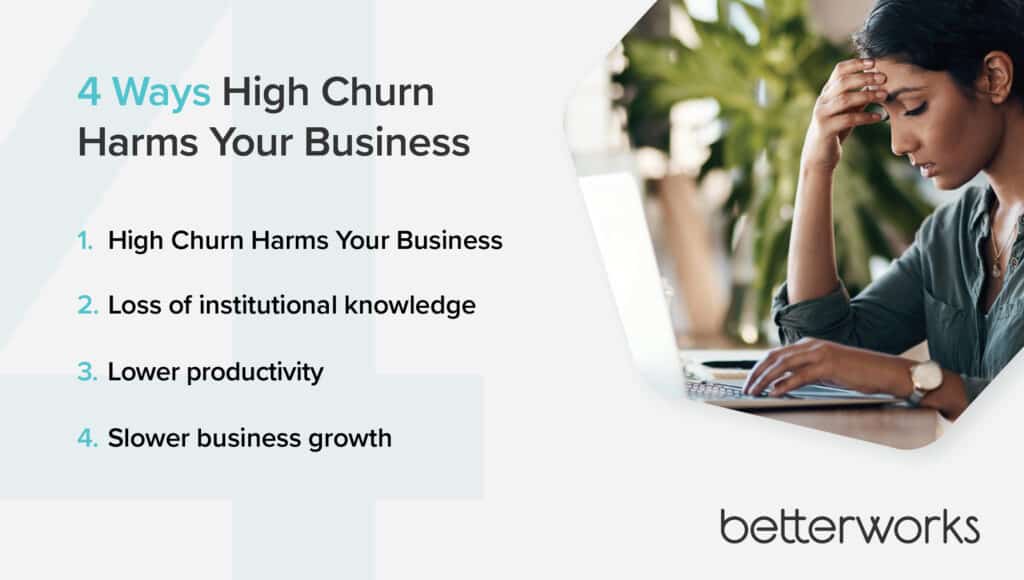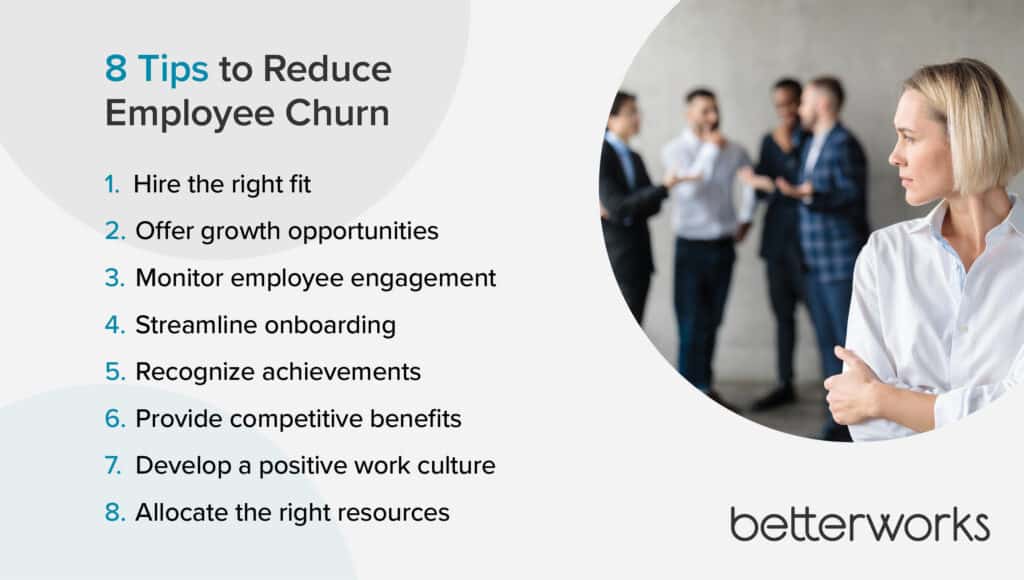The Great Resignation may have given employee churn a name, but this problem has been vexing organizations for some time.
Voluntary turnover is expected to jump nearly 20% this year, from a pre-pandemic annual average of 31.9 million employees quitting their jobs to 37.4 million quitting in 2022, according to Gartner research.
That doesn’t mean you just have to accept the disruption. This quick guide explains what employee churn is, how it affects your business, and the steps you can take to get it under control.
What is employee churn?
The term “employee churn” is sometimes used interchangeably with “attrition” and “turnover,” but they aren’t the same thing. Your employee churn rate includes both your attrition and turnover rates.
Employee churn
Employee churn is the movement of people out of and into your workforce. As people leave your business due to attrition and turnover, your overall headcount is reduced. And as you hire replacements for workers lost to turnover, your overall headcount climbs again. That disruption in workforce numbers is employee churn.
A complete employee churn definition also accounts for both attrition and turnover
Employee attrition
Attrition occurs when people leave your organization but aren’t replaced. Positions left open from attrition may remain vacant for the long term, absorbed into other roles, or eliminated altogether.
In the case of attrition, workers generally leave voluntarily (often to retire or to pursue other opportunities outside the organization) and are not replaced. Since layoffs are involuntary, they’re classified as restructuring rather than attrition.
Some attrition is expected, and it is becoming more common in roles where automation can perform certain tasks more efficiently than people. Some employers use attrition to cut costs in the short term, as in the case of a hiring freeze.
Employee turnover
Turnover occurs when people leave your organization and their vacated roles are filled by new hires.
Employee turnover accounts for employees lost, voluntarily or otherwise, and then replaced. Employees may leave voluntarily for the same reasons as those causing attrition (such as to retire or to seek better opportunities). Or they may be terminated involuntarily for poor performance or misconduct.
Turnover is an essential metric to track because it suggests that employees are unhappy with what you offer them, are disengaging, or do not respond to performance management — among a host of other reasons.
Why are good employees leaving your team?
Any number of reasons could contribute to employee churn. Understanding why good employees leave your business is key to reducing employee churn among your workforce.
Planned exits
You can anticipate some reasons why people leave, and build those exits into your workforce planning. If you have several employees nearing retirement age, for example, you can develop a succession and transition plan ahead of time for transferring their knowledge to the remaining employees.
Unplanned separations
Most separations, however, are unplanned.
Employees may feel that their salary and benefits package isn’t competitive, for example, and believe their work would be better rewarded elsewhere. They may want flexible work options or the ability to work from home. Or they may need to leave to meet their personal or family obligations.
Good workers often leave if they don’t see any path for growth in the company or if they feel that they’ve peaked in your organization. A misalignment between what an employee expects from the company (in terms of purpose, work style, and culture, among other things) and what the company actually delivers can cause people to leave, too.
Turnover in some of these areas can be beneficial. People with strong technical skills but who don’t align well with the culture may struggle to fully engage with the company’s mission, vision, and values, and they’re more likely to disengage from the work.

How to calculate employee churn
Calculating employee churn is fairly straightforward, but it does require that you closely track the number of workers exiting the company.
The employee churn rate formula
You can determine the percentage of employees lost to employee churn by following a simple formula. To calculate employee churn, divide the number of employees who left during a set period of time by the number of employees remaining during that time frame, then multiply that number by 100. For example, if 10 employees left during a given time frame and 100 remained, your churn rate would be 10%.
The employee attrition rate formula
To find your attrition rate, compare the total number of employees you have at the beginning of a set time period to how many you have at the end. If you started the year with 100 employees and only have 92 left by year’s end, then your attrition rate is 8%.
The employee turnover rate formula
The first step to calculating turnover is to determine the average number of employees during a set time frame by adding the total number of employees on day one to the number at the end of the reporting period and dividing by 2. If you start the year with 1500 employees and finish it with 1450, then your average number of employees is 1475.
To calculate the employee turnover rate, divide the number of employee departures in a set time frame by your average number of employees and multiply by 100. If 50 people left during the year and your average headcount is 1475, then your turnover rate is 3.39%.
How can a high churn rate affect your business?
High employee churn can negatively affect the business in multiple ways. Losing and replacing workers costs you in a number of ways.
Higher recruiting costs
In the case of employee turnover, when you plan to replace lost employees, one of the greatest costs of employee churn is hiring and training those replacements. Hiring a replacement can cost anywhere from half of to double that employee’s annual pay. And that figure rises when the labor market is tight and unemployment is low because you may have to expend extra resources to find the right talent and time-to-fill will likely take longer than usual.
Loss of institutional knowledge
Losing a good employee, especially one who’s been with the company for a long time, can take a big toll on your intangible assets — the knowledge, skills, and abilities contained within your workforce. The loss of institutional knowledge that occurs when an employee leaves creates a wider learning curve for incoming employees, increasing the new hire’s time-to-productivity.
Lower productivity
Any degree of employee churn can take a big toll on productivity. A departing employee leaves a gap between the work that needs to be done and the number of employees who can do it. That puts an added strain on employees who stay behind and can disrupt their ability to deliver results at the pace their manager expects. Getting a new hire up to speed to fill that gap can take months or even years.
Slower business growth
A high employee churn rate can slow down your business’s growth. Constantly filling job openings can keep your talent team in triage mode rather than proactively supporting the business strategy. Those unfilled roles also translate into lost opportunities for growth and innovation.

8 tips to reduce employee churn
Although some employee churn is unavoidable, there are steps you can take to reduce unnecessary churn in your workforce.
Hire the right fit
Since employees are more likely to leave if they don’t enjoy the work or align with the business’s mission, vision, and values, finding the right hire is crucial. By incorporating assessments during the hiring process, with the assistance of a Professional Employer Organization (PEO), you can ensure that the person you bring on board aligns with both the job requirements and your company culture.
Offer growth opportunities
Many employees leave because they don’t see chances to grow and evolve within the company. To retain high-performing employees, offer opportunities and the time for learning. That could mean cross-training with another team or taking advantage of learning modules through your learning management system.
Of course, if employees don’t know how to access the right learning resources, they can still feel stuck. Train managers to serve as career coaches to help employees find the opportunities that fit best with their interests and goals.
Keep an eye on employee engagement
Disengagement is one of the key drivers of high employee churn. Monitor engagement closely, and conduct frequent stay interviews to learn the biggest risks to engagement in your workforce.
A lack of direction or purpose in the work can cause employees to disengage. Train managers to communicate their performance expectations to employees clearly, and to emphasize the value of those contributions to the business. Use regular employee engagement surveys to determine points of friction that could drag down engagement.

Streamline onboarding
Onboarding is one of the most critical points in the employee life cycle. Losing the interest of employees at the start of their tenure can lead to higher churn down the road.
Use preboarding to streamline the compliance portion of the onboarding process. On the employee’s first day, focus on welcoming them to the company culture and give them the training and resources they need to begin working immediately. Give managers an onboarding plan to make sure all of the new hire’s needs are met in a timely manner.
Recognize achievements
Recognition is a powerful factor in driving employee engagement. Develop processes for recognizing employees for their achievements. Implementing shout-outs at meetings or tools for recognizing employees via employee engagement software can have a big impact on employee morale and drive greater loyalty.
Provide competitive benefits
Benefits are a key factor in an employee’s decision to leave to look for better compensation and rewards or to remain with your organization. Offering competitive, customizable benefits lets employees create a benefits package that meets their unique needs — and that may not be possible to replicate anywhere else.
Develop a positive work culture
When employees are happy, feel valued, and find joy in their work, they are more likely to remain loyal to your business, improving employee retention. A lot of those positive feelings come from your company culture.
Foster a culture with strong values. Define behaviors that align with company values to help create an environment where employees value each other and feel like they’re part of something bigger than themselves.
Allocate the right resources
Implementing steps to reduce employee churn can require significant resources. Training managers to improve the employee experience, streamlining people processes, and tracking the factors related to employee churn all require an investment of talent, time, and money.

Finding effective employee churn solutions
The ups and downs of employee churn don’t have to define your talent strategy. By actively monitoring attrition and turnover and listening to what’s working for employees (and what isn’t), you can take action to reduce employee churn and create a stable, resilient workforce to carry your business forward.







